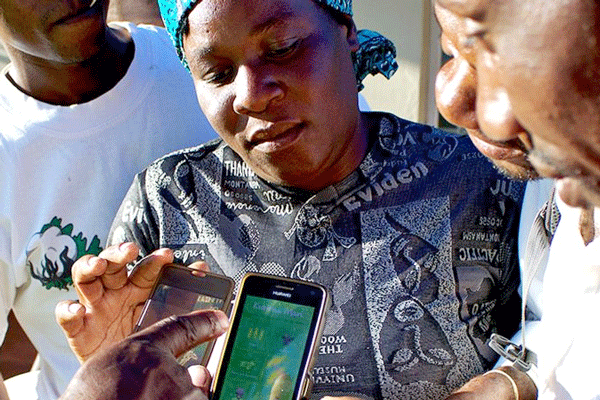
By Tonderayi Mukeredzi
Shurugwi communal farmer Elizabeth Siyapi (57) can no longer be scammed by unscrupulous middlemen to sell her crops cheaply.
Nowadays, before she takes her produce to the market she scours her mobile phone, which has become an essential digital agriculture data bank, for the best prices on the market.
“When my livestock are sick, instead of waiting for an extension officer to physically visit me for help, which may take days, I just consult my phone to look for information on what to do,” she told IPS.
Siyaphi is one of approximately 34 000 small-holder farmers across the country collectively using two smart phone-based solutions, Kurima Mari and Agrishare, promoted by German development agency, Welthungerhilfe Zimbabwe, to find markets, extension services, weather information and hire agriculture equipment.
Tawanda Mthintwa Hove, the head of digital agriculture at Welthungerhilfe Zimbabwe, said farmers have been using Kurima Mari to learn good agricultural practices and link with markets since 2016.
“Kurima Mari is available offline which eliminates the need for buying data. An extension officer updates the application on a regular basis and the updates are shared using Bluetooth making it costless to the farmer,” he told IPS.
“While Agrishare is an online-based solution, it enables farmers to secure the best equipment in their homes, which reduces mobility costs.”
- Chamisa under fire over US$120K donation
- Mavhunga puts DeMbare into Chibuku quarterfinals
- Pension funds bet on Cabora Bassa oilfields
- Councils defy govt fire tender directive
Keep Reading
Over the last three years Siyaphi has utilised digital agriculture to peruse for good agricultural practices. And her maize yield has multiplied from two 50kg bags of the staple grain to over three and a half tonnes.
Hove said that mobile digital technologies improve the quantity and quality of farmers’ harvests by giving them current information on production practices.
They also facilitate linkages, weather advisory services, and add efficiency to commodity systems, which in the long run help increase farmer’s yields and make them more profitable.
In recent years, Zimbabwe has witnessed a rapid growth in the use of digital agriculture.
Paul Zakariya, Zimbabwe Farmers’ Union executive director, told IPS that mobile technology has enabled farmers to get farming advice in real-time, make online payments for inputs and services and access extension services from the tap of a phone, services that were previously available only through pamphlets and meetings.
According to the Food Sustainability Index, created by the Barilla Centre for Food and Nutrition (BCFN) and the Economist Intelligence Unit (EIU): “Precision farming and new digital tools can help, enhancing the efficiency and sustainability of farming, while improving yields”.
But Charles Dhewa, the CEO of Knowledge Transfer Africa, an indigenous systems company that operates eMkambo, another digital agriculture solution, said mobile applications were not yet directly benefiting smallholder farmers here.
“A few elite farmers with appropriate Android phones could be benefiting here and there. That is why we have not positioned eMkambo Nest as a lead solution on our eMkambo platform,” he told IPS.
Dhewa stated that although content was important, many farmers and traders don’t have time and bandwidth to toy with many of the available mobile and digital farming applications.
The channels have reached their limits and are disintegrated, in addition to causing information asymmetry among farmers.
Digital literacy and the high cost of mobile communication is also reversing gains that could have been made by digital technology.
“The high cost of mobile money is worsening the situation, rendering mobile technology more of a luxury than a necessity,” Dhewa said.
“Paying for agricultural commodities through mobile money is now more expensive.”
Zakariya said despite the increased deployment of digital technologies in agriculture, farmers were using information and communications technologies much less to improve agri-business.
Beyond mobile applications, the country has been slow in adopting other appropriate technologies and innovations crucial in commercialising the country’s agriculture, which remains mostly subsistence.
There is little use of high-end technologies with potential to enhance production and value chain competitiveness such as crop protection technology, soil and moisture sensors, drones, precision farming, molecular technology, use of global positioning systems and geographic information systems (GIS).
Zakariya said the uptake of modern, sophisticated technologies was capital-intensive for most farmers while many more farmers lacked knowledge on the use and efficacy of the newer technologies.
Dhewa said GIS has a better future in agriculture than mobile applications sharing information.
According to Hove, it is rural farmers that have been hit hardest by Covid-19 lockdown restrictions and prohibitive data costs, as such many can’t move their produce easily and have been deprived of income.
This has forced some farmers to resort to middlemen.
Still, Hove said, some rural farmers have been able to find markets through the contact list (farmer to farmer) on the app as opposed to using the real-time markets list.
Meanwhile, Siyapi said that she and other farmers struggle to buy data.
As a lead and successful farmer, she requires about $16 a month in data, but says other farmers can make do with $2,20 to download updates and peruse the marketplace. —IPS










